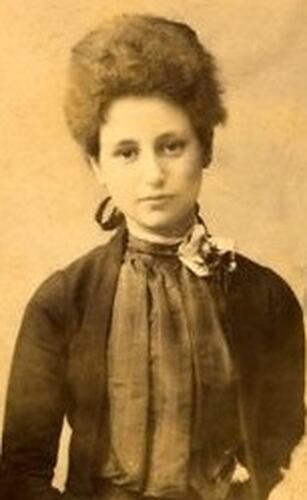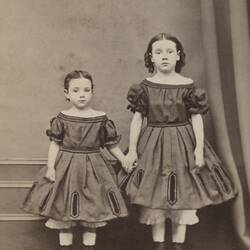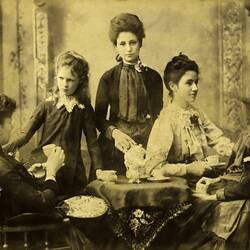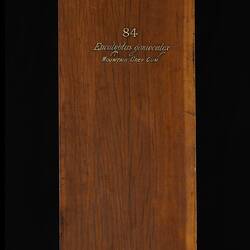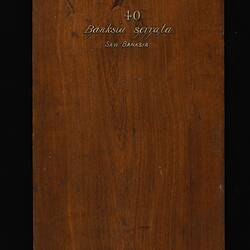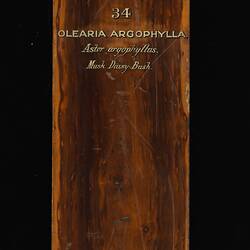'And while glad hearts breathe silent prayer / Of thankfulness to have you there / From pin and gum the birds shall sing / To sound your joyous welcoming!' -- 'Your Homecoming', Alison Rae to May Vale, Paris, June 1892
'Yes I know my London well,' she remarks, smiling, 'I have lived there in all over ten years, but, as you see, I always come back to Melbourne' -- May Vale, in The Southern Sphere, London, December 1910
May Vale was born in Ballarat, Victoria, in 1862. Throughout the course of her life, she would visit Europe three times; the first for family, the second for education, and the third for 'the trip only' (The Southern Sphere, 1 Dec 1910). She was unusual for her period, artists of the same calibre - Jane Sutherland or Clara Southern, for example - never leaving Australia (Topliss pg.35). She was born of supportive parents and was without a young family, two factors that allowed her greater freedom. Moreover, she actively took part in and contributed to an international sphere; a sphere integral to her art practice.
May Vale attended her first meeting with Buonarotti as an art student, on August 6, 1884. A society established in 1883 for 'the cultivation and practice of art, literature and music among its members', meetings were held fortnightly at the Melbourne Coffee Palace, a venue of highrise ceilings and circular tables tops. May qualified for attendance with a 'study of birds in oil' and would go on to attend meetings intermittently for the following two years. It was a significant club, members including Iso Rae, Tom Roberts, Clara Southern and Fred Williams, and its discussions ranging from Michaelanglo Buonarotti to Victor Hugo.
In 1890, inspired by the Buonarotti and European art teachings, she left for Europe. When arrived, she enrolled in a course at the Académie Julian in Paris. The school was a private studio for art students, with notable graduates including Will Ashton, Henri Matisse and Marcel Duchamp. Before enrolling, Vale travelled Europe, visiting Italy, London and France. It was a significant period of the woman's life, from which a decorated fan still survives today. Housed in the collection of the National Gallery of Victoria, the fan was a goodbye gift to May, and includes caricatures, cartoons, sketches and the signatures of fellow students.
Vale returned home in late 1892. For years after, her time in Europe would influence her art practise. She draped her studio in colourful hangings, a reference to Japonism popular in France at the time (The Australasian, May 21, 1898, p.45), and painted a number of European and English subject matters. In 1899, in The Yarra Sculptors' Society Annual Exhibition of Sculpture and Painting, held on Collins Street (December, 1899, cat. no. 64), she exhibited a painting entitled 'La Cigale' - a reference to the famous theatre opened in Paris in 1887. It depicted a woman with large white, billowing sleeves, gazing longingly out a window.
For Australian women artists, the First Australian Exhibition of Women's Work, opened in the Royal Exhibition Building in October 1907, was a defining moment. According to the exhibition catalogue, large scale exhibitions of women's work were not new; the first was held in Vienna in the 1860s (Catalogue, Melbourne, 1907). Melbourne's was significant, however, for its inclusion of works from across the world, including Burma, China, the Philippines, Norway, Greece and Mexico. May Vale, overseas again at the time, submitted a work entitled 'Mayfield', today in the collection of the National Gallery of Victoria. Hung is unison with these works, Melbourne artists' were privileged with a world stage.
This exhibition was held while May Vale was on her third visit to London. Here, at the peak of her career, she reversed roles, introducing the English to Australian symbols and motifs. In December 1910 she was interviewed in her London studio by The Southern Sphere, where she noted her use of Australian design; one example was a gumtree motif on a tablecloth, commissioned by the department store Messrs. Robertson and Moffat (The Southern Sphere, 1910 p.37). This use of Australian design would continue back home in Australia. In 1912, Vale was commissioned to create an album for 'cuttings', for the-soon-departing Governor and his wife. Decorated with wattle blossoms and glue-gums, the album's centre image was of an Indigenous man and his boomerang, representing 'return'.
May Vale lived during a transnational era, with international perspectives strongly influencing her life and practice. From European clubs, overseas academies, parisian paintings, international exhibitions.
Bibliography
Stephen F. Mead, 'The Search for Artistic Professionalism in Melbourne: the activities of the Buonarotti Club, 1883 -1887' The LaTrobe Journal, no.88, 2011, pp.136-147
Buonarotti Club Minutes, 1883-1887, MS 10977, State Library of Victoria
Helen Topliss, Modernism and Feminism, Australian Women Artists 1900-1940, Craftsman House: G+B Arts International, New South Wales, 1996
"Students Exhibition at the Melbourne National Gallery" Table Talk, November 15, 1889, p.5-6
Exhibition Review, Social Notes, The Australasian, May 21, 1898, p.45
"Miss May Vale: Pioneer Enameller", The Southern Sphere, December 1, 1910, pg. 37
Official Souvenir Catalogue, The First Australian Exhibition of Women's Work, Melbourne, 1907, LTMF 24 , State Library of Victoria
Editorial, The Australasian, May 21, 1898, p.45
'Social' Table Talk, Thursday 11 April 1912, pg.30-31
More Information
-
Keywords
Artistic Practices, Exhibitions: Melbourne, First Australian Exhibition of Women's Work, 1907, Women's Work, Artworks, artists, women, Artists
-
Authors
-
Article types
